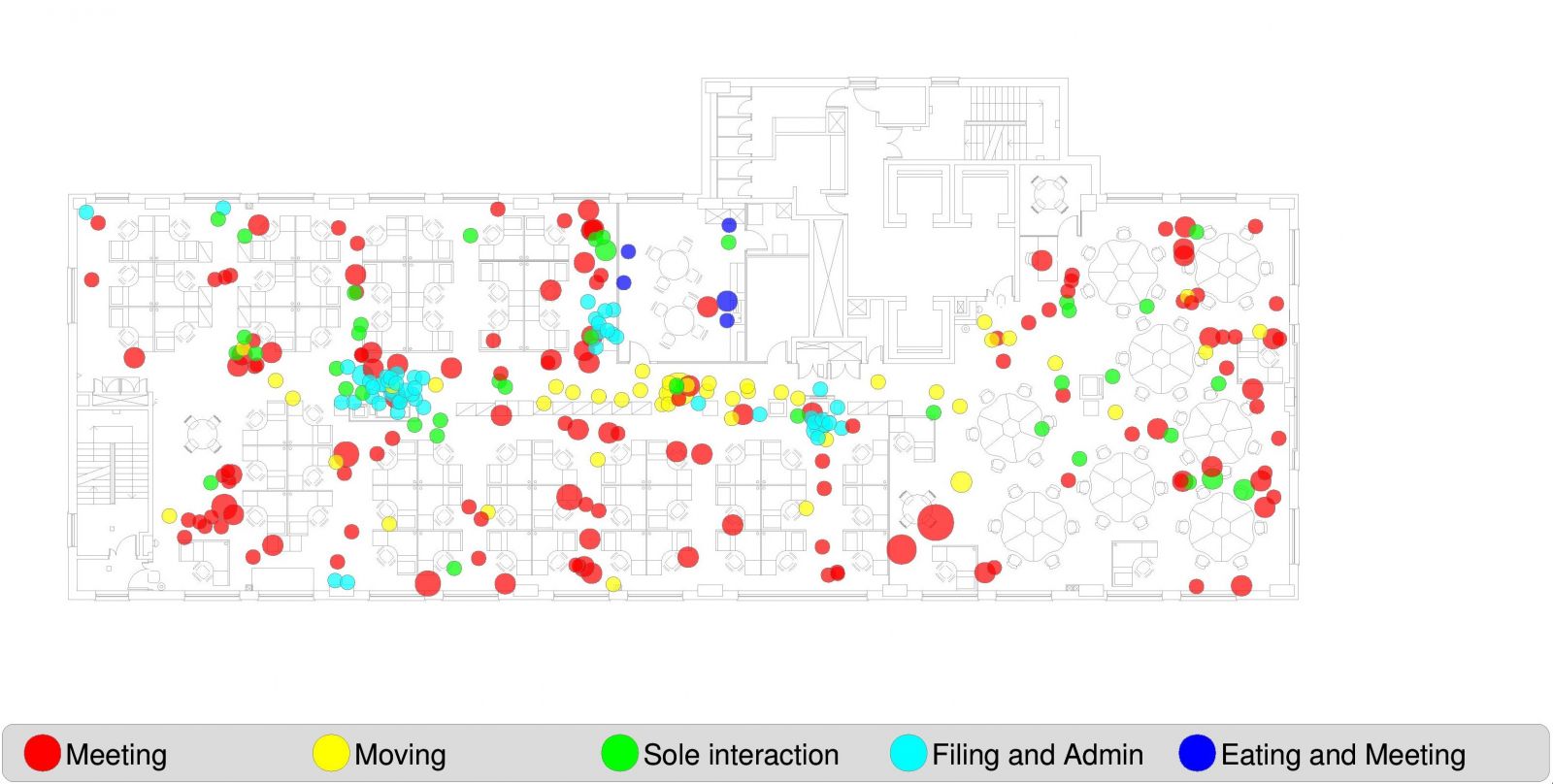Five-Fold Increase in Flexible Working Since 1999
The number of people working flexible hours has increased five-fold in the last two decades according to an analysis of working trends by the Association of...
Read Full Article
The measurement of office efficiency has taken a step forward with the introduction of behavioural analysis – Graham Bird explains.
Over time, the tools and methods we have developed to analyse our workplaces have taken great advances. For some time, we have been able to use technology to accurately assess the numbers of workers using specific areas of a working environment, using hand held tablets to record details of occupancy in various areas.
‘Under desk sensors’ then helped to take this analysis a step further offering real-time information on desk occupancy and utilisation and presence in all areas of a building.
The results and reports of such studies further enhanced our insight into vacant space and utilisation identifying the areas where presence is highest or lowest, in a single office or even across a portfolio of buildings.
Using this evidence, we are now able to make informed decisions on matters such as lease renewal, churn, down-sizing and expansion. However, whilst these tools provide an accurate insight into the function of the office, they leave out one critical piece of the workplace puzzle, information about the most important asset of any business - its people.
That is until now, as the latest advance in workplace analysis now focuses on behavioural activity - which goes beyond helping us understand where people are and begins to explain what, how and most importantly, why.
Behavioural Activity
How does it work? Much like tablet based space utilisation analysis, human activity is recorded regularly over a long period of time via a web based application. However, when an assessor monitors a building, rather than make a regular assessment of how many people are present within an area, an observation is also made to evaluate the type of behaviour and activity occurring within every space. This is known as ‘Activity Sampling’.
Depending on the activity occurring (whether it is an informal gathering, a group related collaboration, a form of relaxation, solo work or a relaxed chat) details of each staff member, their behaviour and location, can be recorded by an evaluator.
For example, if you consider a space where activity may occur, an assessor (who must be trained to read and identify specific forms of working behaviour), would monitor this space and may observe a group of three colleagues engaging in an incidental collaborative meeting in the area.
The assessor will then enter these details of the activity onto a map, on the hand held device. When the study is complete, details of this particular area can be examined via easy to read maps of the workplace.
Now, imagine that the investigation finds that collaborative interactions of this kind are occurring twelve times per week in this particular area. It may be due to a lack of suitable meeting environments anywhere near this space. It may also be that the meeting environment designed for such interactions is actually underused, because it is poorly located. It may be that certain departments rarely communicate (but need to) and only get the opportunity when they meet incidentally travelling from one environment to another. So this may lead to the question is it a good idea to provide an informal space close to or even within this area to accommodate the needs staff are already demonstrating?
Whatever the issue, the point is, without observing behaviour over a lengthy period there is a good chance you’ll never understand staff needs and how to make the changes to best support them.
The power of analysis
The final results of activity sampling will give you a broad insight into where your workplace is succeeding or failing. For example, you can build data on how well specific communal facilities are utilised, allowing you to assess why a certain printer may be used constantly, yet the other four are rarely visited. A study may also reveal that there are well-trodden paths to particular desks, which leads to questions such as why is this particular desk of great interest? Does this person have great experience or knowledge and therefore should they be located centrally? It may be that they are an outgoing, interesting, fun person, in which case, are they suitably placed here? Maybe they should be in a more open space, or communal environment. Furthermore, if you wanted to look at things from an HR perspective, they may be the perfect candidate for an up-coming managerial role!
In summary, the close analysis of how staff currently work by recording details of behavioural preferences will empower a business with a core understanding for what is required to improve efficiency.
Once we know what is happening, we can then consider the question - why?
Picture: Graham Bird, Strategic Space Consultant at Baker Stuart Baker Stuart is a professional workplace consultancy focused on transforming the way we work.

The map above reveals layered data indicating where each specific action may be taking place, informing you of where staff meet, the size of the meetings, popular travel routes, what cabinets are most frequently visited and more.
Article written by Graham Bird | Published 18 August 2016
The number of people working flexible hours has increased five-fold in the last two decades according to an analysis of working trends by the Association of...
Read Full ArticleYour company is merging. Now what? Trina Marshall, of HOK Consulting's London office provides a guide to corporate real estate planning. Mergers and...
Read Full ArticleCBRE Group has purchased Romonet, a global company that utilises cloud based analytics software to unlock efficiencies and increase capacity at data centres. John...
Read Full ArticleEmcor UK, has been awarded a contract with multinational insurance company RSA Insurance Group which is being described as a total facilities management contract. It will...
Read Full ArticleUpdated guidance to help in-house FM teams understand what is involved in managing and changing space has been published by the British Institute of Facilities Management...
Read Full ArticleForbo Flooring Systems’ new loose lay Luxury Vinyl Tile (LVT) collection, Allura Flex 0.55, consists of contemporary reclaimed wood designs and natural stone...
Read Full ArticleMaking alternative workplace strategies work for space planners is examined by Chris D’Souza of ARCHIBUS Inc. Alternative Workplace Strategies (AWS) are, in...
Read Full ArticleThe improved Manhattan Integrated Workplace Management System (IWMS) and Manhattan Space Scheduling are now available in the UK. Space management and...
Read Full ArticleThe NFS Technology Group has joined forces with Harman’s AMX to break down a frontier and introduce a seamless solution between room space scheduling and digital...
Read Full ArticleNFS has been awarded the Microsoft Gold Partnership for the latest meeting room and resource management software, Rendezvous Workspace. Built around the latest...
Read Full Article